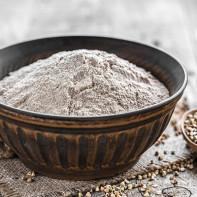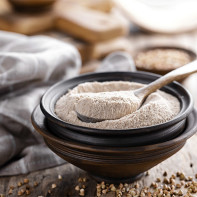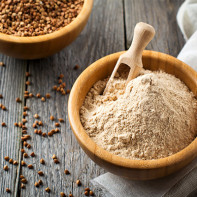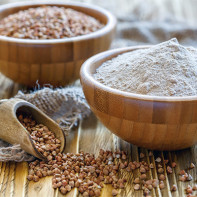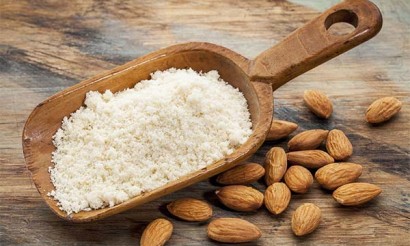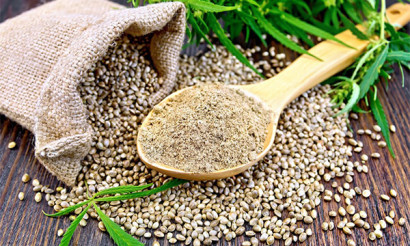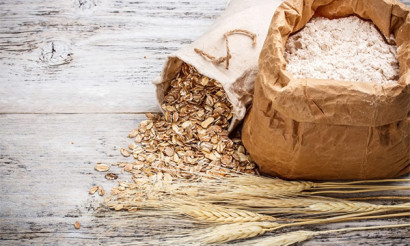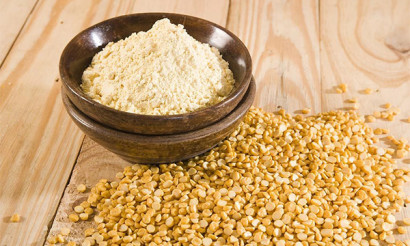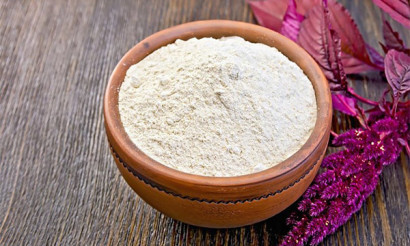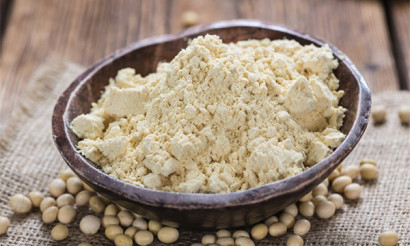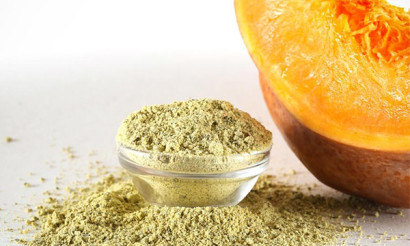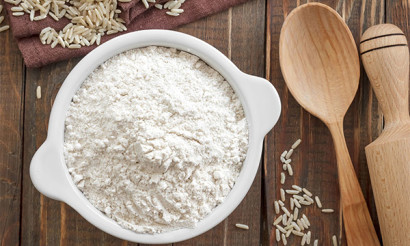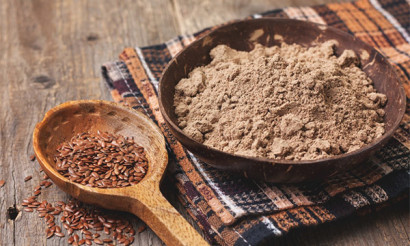Buckwheat flour: useful properties and contraindications
Buckwheat flour is widespread due to its unique vitamin composition and special taste. Visually, this product differs from its wheat counterpart only in color characteristics, but it has more useful properties.
- Composition and calories
- What is useful for buckwheat flour
- For women
- For men
- Pregnancy
- Breastfeeding
- For children
- For weight loss
- Buckwheat flour with kefir: benefits and harms
- Buckwheat flour in medicine
- Diabetes mellitus
- For pancreatitis.
- For intestinal use
- Buckwheat flour in cosmetology
- For Face
- For Hair
- Health Hazards and Contraindications
- How to Choose and Store Buckwheat Flour
- How to make buckwheat flour at home
- What can be made of buckwheat flour: Recipes
- Pancakes
- Bread
- Cookies
- Pancakes
- Porridge
- Scones
- Muffins
- Interesting Facts about Buckwheat
The product's native land is Asia. In these parts are well aware of the useful qualities of buckwheat flour and greatly appreciate it. Although the product of wheat is more popular around the world, but buckwheat flour is also widely used. It is added to dietary and children's dishes, pastries.
Composition and calories
Iron, sodium, iodine, calcium, phosphorus, zinc, potassium and magnesium - this is an incomplete list of micro- and macroelements contained in buckwheat flour. In addition, this product is rich in vitamins B, C, E and PP. The presence of many nutritional components allows the use of this product in various spheres of consumption. At the same time, the beneficial effects of buckwheat are very tangible for the body.
The ratio of proteins, fats and carbohydrates in buckwheat flour is presented as 13.6:1.2:71.9 g.
The caloric value of the product is 340-353 kcal, which does not prevent its use in a dietary menu.
What is buckwheat flour good for?
The energy composition of buckwheat flour determines its useful properties. Here it should be mentioned that the most useful is the flour made by hand. This is due to the fact that most of the important components are placed in the husk. In industrial production, the husks are separated completely, sacrificing most of the vitamins and minerals. At home, however, it is impossible to completely separate the buckwheat kernel from the husk, so homemade flour is more nutritious than market or store-bought flour.
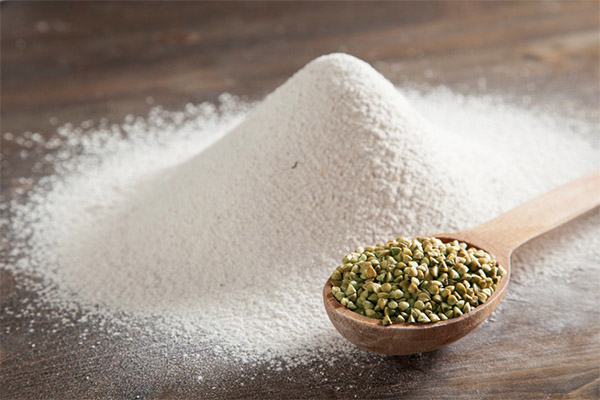
For women
Women's bodies benefit greatly from eating dishes made of buckwheat flour. In addition to the fact that it promotes weight loss, buckwheat also normalizes hemoglobin levels. This is important on different days of the cycle to keep women healthy.
For men
For men buckwheat flour can be used to replenish the vitamin and mineral balance in the body during excessive physical exertion, as well as during periods of targeted muscle gain. The product is also unique in that a balanced intake of nutrients simultaneously has a regulating effect on the digestive system and glands involved in the processes of food transformation.
During pregnancy
Buckwheat flour can be used as an alternative to wheat flour during the fetal period. It is nutritious and its glycemic index is minimal.
When breastfeeding
Breastfeeding is usually accompanied by a certain restriction in the diet. During this period, buckwheat flour is especially useful, from it you can prepare many nutritious and delicious dishes.
For children
This product is used as a safe component of children's food, and can also serve as a complementary food at the initial stages of acquaintance of the child with adult food. Dishes made of this flour appear in the diet of children from the age of six months. They are cooked first with water, gradually introducing milk.
When losing weight
Flour made from sprouted buckwheat is often used as organic food, since it contains four times more niacin and several times more folic acid and vitamin B6. At the same time, there is half as much starch, so this product is considered the most suitable for those who want to lose weight.
Buckwheat flour with kefir: benefits and harms
The nutritious tandem of kefir and ground buckwheat has a beneficial effect on the condition of blood vessels and the liver, so it is widely used as a component of weight loss diets and cleansing programs.
The most common recipe for a nutritious drink, according to which buckwheat flour (1 tablespoon) pour kefir (one cup). Rest the mixture in the cool, thanks to which there are natural fermentation processes.
Kefir-wheat mixture is used for therapeutic purposes for several weeks every morning on an empty stomach. However, you should use this recipe with caution in case of liver diseases and gastrointestinal malfunctions.
Buckwheat flour in medicine
The unique useful qualities of buckwheat flour have led to its wide use both for food purposes and for the treatment and prevention of a number of ailments.
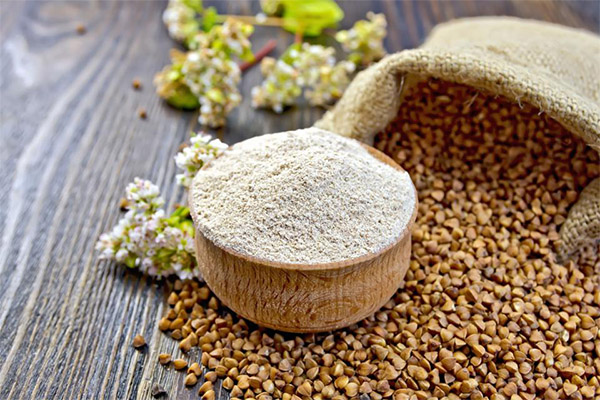
So, its use allows to strengthen blood vessels, normalize the work of many organs and systems of the body.
For diabetes
Buckwheat flour helps normalize blood glucose levels, which is important in the case of diabetes. In addition, for diabetics, this product is also useful due to its low glycemic index (the index is only 54).
Often, to regulate the sugar balance, an infused mixture with kefir is used. The period of treatment with this mixture is about three months.
In pancreatitis
Pancreatitis and thyroid disease require a certain diet, in which buckwheat flour can be used to maintain hormonal balance. The recipe for the healing dish is simple: ground buckwheat is mixed with honey and walnuts (200 g of each component). Consume the therapeutic mixture should be one spoonful before a meal.
For the intestines
Buckwheat flour stimulates the outflow of bile and intestinal peristalsis. To normalize the intestinal microflora and improve its motility, the intake of flour in combination with kefir is most often recommended. The chilled, steeped product is considered the best option for the treatment of the intestines.
Buckwheat flour in cosmetology
It is noteworthy that ground buckwheat is often used for cosmetic purposes. It is an active ingredient in nourishing and cleansing facial products and is also used by women as a component of hair and body care products. The advantage is that it is easy to use at home on its own.
For face
- As part of masks for the beauty and health of facial skin, this product can act as a moisturizer. For this purpose, ground buckwheat (20 grams) is mixed with the yolk of one egg, a teaspoon of honey and chopped plums without skin. The mixture is applied to a face cleaned of makeup and kept for a quarter of an hour. To rinse, warm water is suitable.
- In mixtures for greasy skin, flour is poured into a previously prepared chamomile broth. The consistency should resemble a thick porridge. The mask is washed off after 20 minutes of being on the face.
- Surprisingly, it is possible to obtain a mask-film from buckwheat flour. Such a variation is excellent for sensitive skin. In addition to flour, a spoonful of gelatin, decoction of chamomile or room temperature water is added to the mask. Additionally, aloe juice is added to such a composition. After applying the mask dries for half an hour, then it is removed in one layer, taking hold of the edge. After removing the face wash with cool water.
- For face and whole body is effective mask with milk. In its preparation buckwheat flakes are poured with milk and waited until they swell. The product is applied to steamed skin, wait about 20 minutes and then rinse thoroughly.
- Ground buckwheat mixed with a little honey is also used as a skin nourishing agent.
For the hair
Buckwheat flour can help eliminate oily hair. To do this, it must be mixed with the lemon juice of half a fruit, then pour the components with milk until a paste-like mixture is formed. Apply the mask to the hair after shampooing and soak for 30 minutes. Rinse your hair with shampoo, which will get rid of all the residue.
Harms and contraindications
For people with gluten intolerance, it is important to find out before using whether buckwheat flour was produced separately from wheat flour, because even traces of wheat in the product can be harmful.
In spite of a number of beneficial effects of buckwheat flour, it can also have negative effects. This product contains allergens, so such reactions to buckwheat as swelling, redness of the mucous membranes of the mouth and eyes, itching, swelling of the throat, nausea or vomiting, shortness of breath, dizziness, intestinal disorders, nasal congestion and rhinitis of allergic nature are not rare. Laryngeal edema is the most dangerous, as it leads to anaphylaxis, a severe form of allergic reaction leading to suffocation. If the slightest hint of this symptom is found, medical attention should be sought immediately.
Surprisingly, the heat treatment of buckwheat flour has no effect on its ability to cause allergies, because the allergens in it show resistance to high temperatures.
Besides, buckwheat flour contains a lot of fiber, which can be dangerous for people suffering from Crohn's disease or irritable bowel syndrome. Eating the product in people who have problems with peristalsis and excessive gas can lead to indigestion and intestinal cramps.
How to choose and store buckwheat flour
For baking, usually choose buckwheat flour of a darker shade. This is due to the fact that it gives more flavor and rich color to the finished dish.
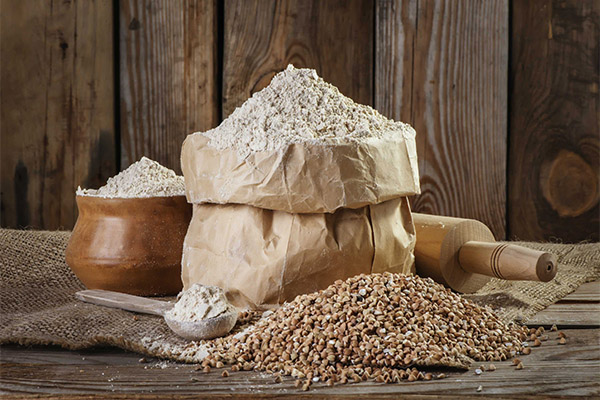
Because buckwheat flour is high in fat, it tends to go bad, so it is extremely important to choose a fresh product. This is especially true in the summertime, as rancidity of the product manifests itself earlier under the influence of high air temperature. Health problems can be caused by rancid buckwheat flour only if it is used repeatedly. It can lead to clogged arteries and damage to body cells.
From the time of purchase the product should be placed in a cool place in a tightly closed container. The shelf life after opening the package with flour is no more than three months.
How to make buckwheat flour at home
The undoubted advantage of the product of own production is that in this case you can be absolutely sure of the composition.
Before milling, buckwheat groats should be thoroughly washed, thus getting rid of trash. Then it should be thrown on a sieve and dried. You can grind buckwheat with the help of any handy kitchen equipment.
What can be made from buckwheat flour: recipes
There are many options for dishes prepared on the basis of buckwheat flour. This product fits perfectly into a dietary menu, and is also often used by those who follow the principles of proper nutrition. Cakes made with buckwheat flour are not inferior to the delicacies made with wheat flour, preserving their useful properties even during heat treatment.
Delicious muffins and pancakes and noodles made from this valuable flour are pleasing in taste and very nutritious. People who try to avoid flour in favor of the figure will like cakes and muffins, and buckwheat bread will not leave anyone indifferent. At the same time, these healthy dishes look quite attractive and whet the appetite.
Pancakes
Pancakes made with buckwheat flour are a great solution for a snack or breakfast. They turn out dietary and tasty.
To prepare this dish you will need: a mixture of buckwheat and wheat flour in equal proportions (200 grams each), a teaspoon each of salt and sugar, a little over two cups of milk, a pinch of baking soda and three eggs.
Before mixing the ingredients, the flour should be sifted. Dilute the milk with a little water, and then introduce the loose ingredients (salt, sugar and baking soda). Next, introduce eggs whipped with a mixer into the liquid mixture. The yolks should be beaten separately from the whites, so the pancakes will turn out more airy. As the last step, add sifted flour into milk. Knead the dough thoroughly. Bake the pancakes in a frying pan, with a little oil.
Bread
Bread made of buckwheat flour is very crumbly. This is due to the fact that buckwheat flour lacks gluten, which makes the finished product porous.
To bake bread, you will still need to introduce a certain amount of wheat flour. The ideal ratio is 1:1 or 2:1 (where most of the wheat flour is used). Finished buckwheat bread has a baking flavor. The flour for baking should be as ground as possible.
To get two loaves of bread, weighing about 400 g each, you will need: yeast (15 g), 0.5 kg of wheat and 160-200 g of buckwheat flour, sugar (2 tablespoons), salt (2 teaspoons), warm water (about 2 cups), and several spoons of vegetable oil.
The first thing to do is to prepare the sourdough. Crush the yeast with sugar, pour warm water (half of the recipe volume). To this mixture add a glass of flour, then stir it and send it to a warm place for twenty minutes.
When the stew doubles in volume, bubbles appear, the rest of the warm water should be added. After that you can move on to kneading the dough. The amount of flour you add depends on its quality, so you need to watch the consistency of the dough.
Before the end of the kneading, when the dough is already steep enough, you can add salt and vegetable oil. The final touch is to give the dough a dense texture by kneading it by hand. This process is quite long - about 15 minutes, but it ensures that the future bread is lush. While kneading the dough by hand, wheat flour actively gives off gluten, so that the finished product will hold its shape. By the way, in the wheat-wheat mixture gluten is released less.
After kneading, the dough should be placed in a bowl greased with oil, covered with a towel and put in a warm place for an hour. During this time, the dough will rise twice more. It should be divided into two equal parts, form loaves and put into greased molds. Place the filled molds in a warm place for another hour to allow the dough to rise again. Afterwards, brush both loaves on top with flour mixed with water, or sprinkle with seeds of your choice.
The temperature and baking time of the bread depend on the characteristics of the oven. As an initial recommendation, you can focus on 150 ° C (bake for the first 20-30 minutes), and then increase the temperature to 200 ° C and bake for another 10 minutes. The entire baking process should be monitored with a wooden skewer, which can be used to see how the bread is baked.
When ready, let the bread cool without taking it out of the mold, and then take it out. Cutting buckwheat bread is recommended cooled.
Cookies
Buckwheat cookies are a delicious and healthy treat that you can indulge in without harming your figure.
To make the cookies you will need: about 100 grams of buckwheat flour, two eggs, honey and vegetable oil - two tablespoons each, a little vanilla and soda (2 g each). If desired, you can add dried fruits and seeds (sesame, flax). On average, the preparation of buckwheat cookies takes about 40 minutes.
The dough for healthy cookies can be made quite quickly - in 10 minutes. First, you should sift the buckwheat flour. Then beat the eggs with honey (you can replace the sugar) to a fluffy consistency. In the flour, introduce the baking soda and pour the beaten eggs. Then add vegetable oil and start kneading. Knead the dough with hands soaked in water, so that it does not stick. If desired, you can add dried fruits or seeds.
Bake the cookies on a baking tray lined with parchment paper at about 180°C. Buckwheat cookies bake quickly, it is important to watch their readiness. Usually this time does not exceed 15 minutes.
There is also a diet version of buckwheat cookies. It does not include eggs, but as ingredients use kefir (150 ml), bran (most often rye - about 1 tablespoon), 1-2 apples and seeds of your choice.
The calorie output of diet buckwheat cookies is about 72 kcal, and the entire cooking process takes about 90 minutes.
If the buckwheat flour for such cookies is made at home, it is not necessary to bring it to powder. It is enough to grind the groats a little in the amount of 1 cup. To half a cup of ground buckwheat mass add grated apples without peel, oil (it is better to take olive oil), kefir, honey (you can replace it with syrup) and bran. Mix the mass and let it stand for 20 minutes. Ready to bake the mass should set and not be crumbly. Kefir can give additional viscosity. Separate small pieces from the buckwheat mass, roll them into balls, and then form them into tortillas. You can sprinkle sesame seeds or seeds on top.
After an hour of baking at a temperature of not more than 150 ° C, you get a useful and very tasty cookies, which are not harmful to the figure.
Fritters
To prepare healthy fritters, you will need a mixture of buckwheat and wheat flour (100 g each), two chicken eggs, a cup and a half of kefir, sugar (4 tablespoons), half a teaspoon of soda.
All the ingredients should be combined and kneaded to the consistency of sour cream. On a preheated frying pan put the batter with a tablespoon, fry on both sides until a crust forms a ruddy crust. The whole process of cooking buckwheat pancakes takes about 30 minutes.
Porridge
Porridge made with buckwheat flour can be served to both adults and young children. The dish turns out delicious and tender. Since buckwheat porridge contains many vitamins and nutrients, it is used as a dish for the first complementary food for infants. If the dish is prepared for the baby, its consistency should be liquid. Gradually, the thickness of porridge can be increased.
The recipe for making porridge from buckwheat flour is quite simple. To get a liquid dish, take one teaspoon of buckwheat flour per 100 ml of water (or milk). Mix the ingredients, put them in a saucepan and cook over low heat until boiling, stirring. Porridge for babies is not salted. You can add breast milk to the porridge, so that the dish is better absorbed by the baby. After boiling, boil the porridge for another 15 minutes and then leave it to soak under a lid for several minutes.
Children after one year and adults can add dried fruit, sweeteners (sugar, honey or syrup) and salt to buckwheat porridge.
For adults, buckwheat porridge is cooked the same way as for babies. The only difference is the ratio of ingredients. Buckwheat flour should be taken more to get a thicker dish.
Scones
Buckwheat cakes are made similarly to pancakes or pancakes. However, you should use water as the liquid component and minimal frying oil to get a diet dish.
Muffins
Baking with buckwheat flour is fast and easy to prepare. When using buckwheat muffins, there is almost no risk of gaining excess weight, in addition, they are very tasty and healthy.
The recipe for the muffins can be changed to your liking, adding ingredients that the household likes. The classic recipe for buckwheat muffins with the addition of cocoa is quite simple, and the result is a pastry that has the consistency of a mannik.
To make four muffins you will need 50 grams each of sugar and cocoa, 50 ml of refined butter, one egg, a few tablespoons of water, a third of a teaspoon of baking soda and a total of 500 g of buckwheat flour.
First, you must separate the egg white from the yolk and whip it into a thick foam. Grind the cocoa and sugar with the addition of butter and egg yolk. When the mixture is homogeneous, add water and flour, mixing thoroughly. When the dough is as thick as sour cream, add the baking soda. The final touch is to add the whipped egg whites. This process is very delicate, you should not hurry. You should smoothly mix the resulting dough, then you can spread it out into forms. Bake in an oven heated to 180 ° C. Check the readiness with a toothpick.
You can experiment with the composition of the dough, mixing different kinds of flour, and the finished muffins can be decorated at your discretion with powdered sugar, chocolate, cream or confit.
Interesting facts about buckwheat
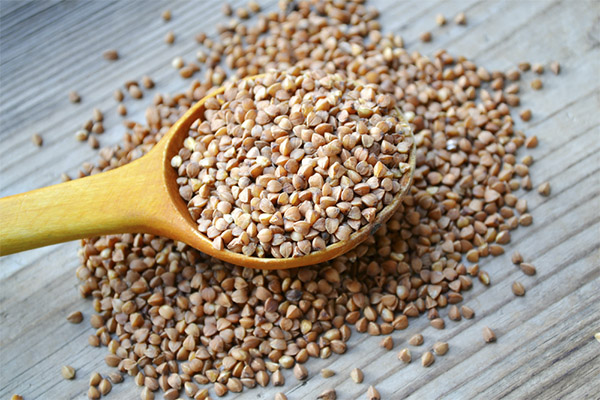
- Surprisingly, buckwheat is fully consistent with the notion of an environmentally friendly product. This is due to the fact that this crop does not need any stimulants to grow. It grows perfectly by itself, no chemicals are added during its cultivation. That is why buckwheat can be safely eaten.
- Buckwheat grits have enormous nutritional value. In Asian countries it is believed that this product can stimulate the bio-energy points of a person, thereby activating the metabolic processes in the body. That is why in China and India it is a popular procedure to walk on a buckwheat mat. This method is used for prevention of several diseases.
- The smell of buckwheat has a favorable effect on the receptors and promotes restful and deep sleep. That is why people suffering from insomnia are recommended to sleep on a pillow filled with buckwheat husk.
- Emotional background can be improved by eating buckwheat porridge. The macronutrients it contains stimulate the brain, resulting in an improved mood.
- In Japan, buckwheat is an integral part of traditional dishes. In almost all Japanese restaurants you can find soba noodles made from buckwheat flour on the menu.
- Pre-roasting buckwheat before cooking makes it more delicious. This trick is often used by tourists and fans of this culture.
- Three essential amino acids (lysine, tryptophan and threonine) are found in buckwheat. So for those who have decided to give up meat in their diet, buckwheat can serve as an excellent substitute and source of these compounds.
- The value of buckwheat for dietary nutrition is unique. The many beneficial substances that are contained in buckwheat in large quantities contribute to weight loss. In addition, buckwheat stimulates the elimination of excess fluid from the body.
- Buckwheat groats are a real treasure trove of useful substances. For example, vitamins P and PP help to strengthen the vascular walls, and acids (malic, oxalic, citric and maleic) are involved in maintaining the acid balance in the digestive system and contribute to the removal of salts from the body.
- Buckwheat contains a large amount of iron, so it is useful for people with low hemoglobin levels.
- The problem of permeability of blood vessels can be solved with the help of buckwheat. This product promotes the dissolution of cholesterol plaques on the vascular walls and the excretion of decay products.
- When buckwheat is consumed, the blood glucose level increases gradually, unlike other products, when the concentration of sugar changes abruptly.
- Buckwheat grits contain lipolytic substances, which prevent liver degeneration and improve the function of endocrine glands.
- In terms of protein composition buckwheat is close to milk powder and chicken egg protein. The proteins from buckwheat are much easier to digest than those from meat products.
It is difficult to overestimate the useful properties of buckwheat flour. It is a product with a high energy and nutritional value. It is these qualities that have allowed buckwheat to spread everywhere as a food product for maintaining the normal functioning of the human body.
«It is important: All information on this site is provided solely for introductory for your own health. Before using any recommendations, you should consult with a specialist. specialist before applying any recommendations. Neither the editors nor the authors shall be liable for any possible harm caused by materials."

